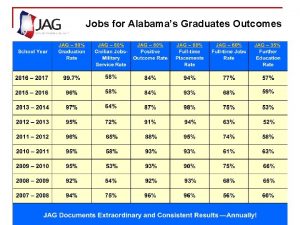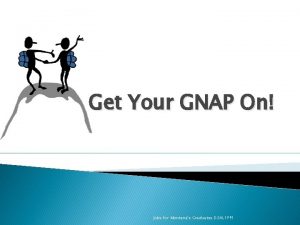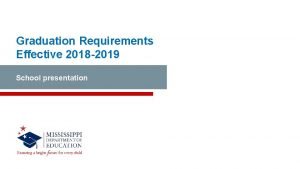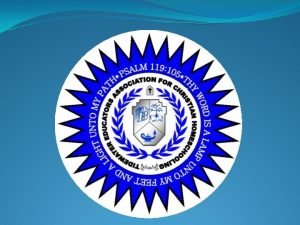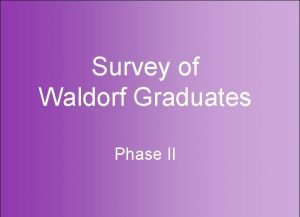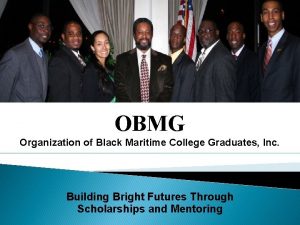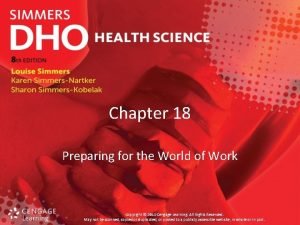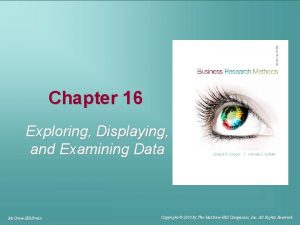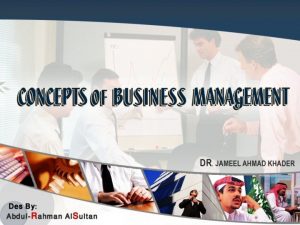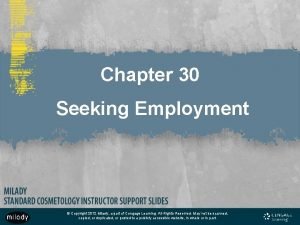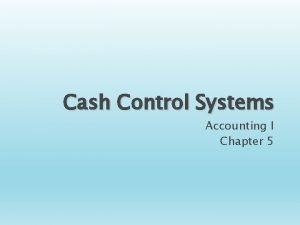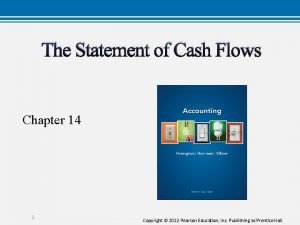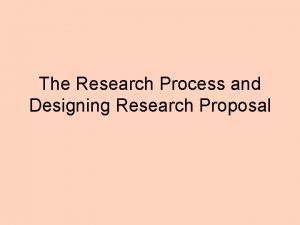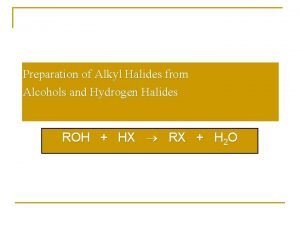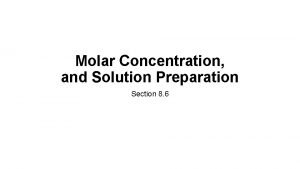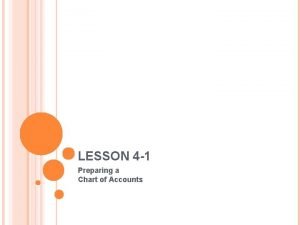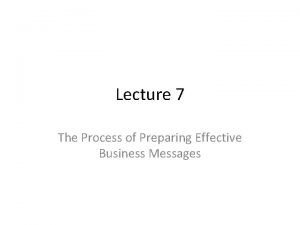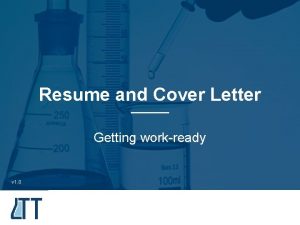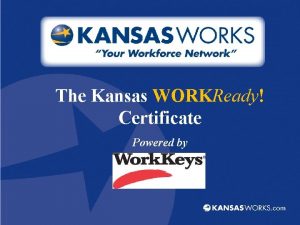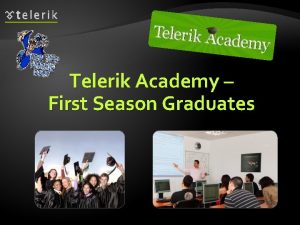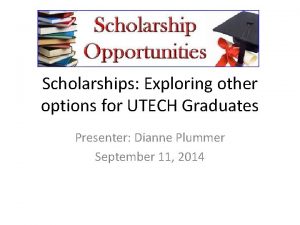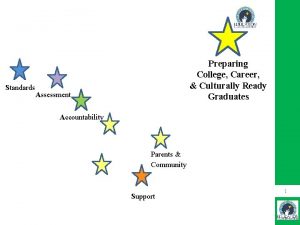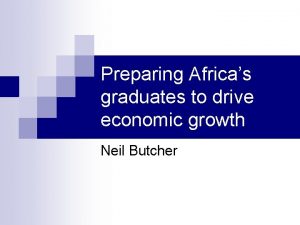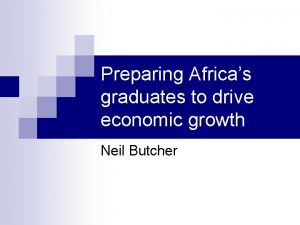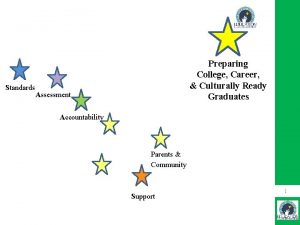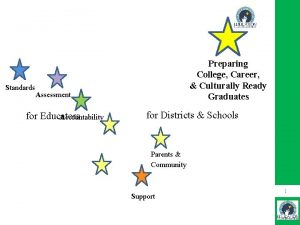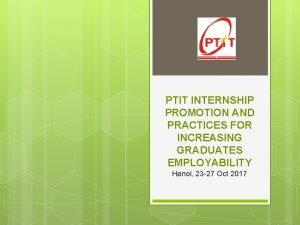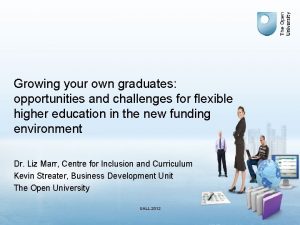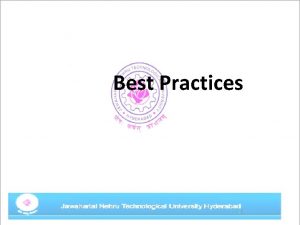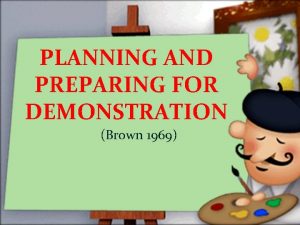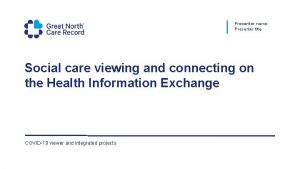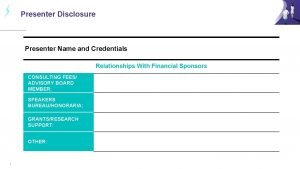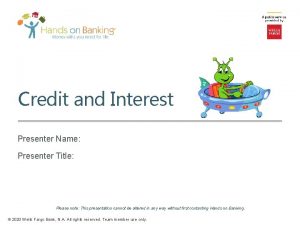Practices and Challenges of Preparing Workready Graduates Presenter






























- Slides: 30

Practices and Challenges of Preparing Work-ready Graduates Presenter: Lela Faulkner-Douglas Excelsior Community College, Jamaica April 2015 1

Introduction q. Globalisation and the pervasiveness of technology are powerful forces affecting the twenty-first century workplace. q. Businesses, educational institutions and individuals are faced with new realities. 2

Introduction q. It takes more than a degree to compete in the present volatile labour market. q. Businesses are interested in individuals who can add immediate value to their organisation and therefore demand graduates who are work-ready. 3

Introduction q. Technical and non-technical skills are deemed necessary for work-readiness. q. Employers are dissatisfied with the quality of graduates entering the world of work (Wilton, 2012). 4

Introduction Statement of the Problem A number of studies explored the expectations of twenty-first century graduates. q q. Not much empirical studies on the workforce readiness of community college graduates in Jamaica. q. This study is designed to look at a 5 community college approach to preparing work-ready graduates.

Introduction Purpose of the Study q. The purpose of this study was to explore the practices of educators in a Jamaican community college in preparing students for the workforce. q. A discussion of teaching and learning practices, curriculum evaluation and review practices and industry participation is presented. q An insight into the challenges encountered by the institution in preparing students was also examined. 6

Introduction Research Questions 1. What are the teaching and learning activities engaged in by lecturers in preparing students for the workforce? 2. What is the level of industry participation in the curriculum development and implementation? 3. What are the challenges faced by educators in ensuring work-ready graduates? 7

Review of Literature Identifying work-readiness q Work-readiness is defined as “possession of skills, knowledge, attitudes and commercial understanding that will enable new graduates to make productive contribution to organisational objectives soon after commencing employment” (Mason, et. Al, 2009; p. 1). 8

Review of Literature Identifying work-ready skills cont’d q. Both technical and non-technical skills are required to produce work-ready graduates (Jackson, 2013). q. Non-technical, generic, core, professional, 9 key or work-ready skills are all terms used interchangeably with employability skills (Yorke & Knight, 2004, cited in Jackson, 2013).

Review of Literature Work-ready skills and attributes �Planning and Organising �Problem-solving and Critical Thinking �Research �Ethics and �Self-Management and Professionalism Lifelong Learning �Global and Local � Team-work and Perspectives Leadership �Information Literacy and �Technology Literacy Management �Communication �Initiative, Enterprise and 10 Creativity (Litchfield, Nettleton & Taylor 2008; Lowden, Hall, Elliot & Lewin, 2011)

Review of Literature Employers Perspectives of work-ready graduates q Technical skills are easier to teach on the job, hence they prefer graduates being very proficient in generic skills (Litchfield, Nettleton & Taylor, 2008) q Graduate employees are inadequately prepared for entry level work (Cabellero & Walker, 2010) 11

Review of Literature q. The gap in the skills that employers demand what the graduates possess can cause reduced productivity and lead to underperformance in the organization. (Jackson, 2013). q. The responsibility of ensuring graduates 12 acquire the relevant non-technical skills remains with the school (Hancock, Howieson, Kavanagh, Kent, Tempone & Segal, 2009; as cited in Jackson, 2013).

Literature Review q. Graduates’ attributes cannot be adequately assessed until students enter the workforce (Nagarajan & Edwards, 2014). 13

Literature Review Higher Education Institutions’ Practices in Preparing Work-ready graduates q The use of technological tools actively engage students in the learning process and enhances creativity (Bhaumik, 2012; Bassendowki & Petruka, 2013; Bell, 2010). 14

Literature Review q Project-Based Learning allows students to apply their knowledge through a project (Bell, 2010) q PBL is aimed at promoting active learning among students, catering to students with different learning styles ( Pinho-Lopez & Macedo, 2014) q PBL has significant impact on students’ employability and professional success (Pinho. Lopez & Macedo, 2014). 15

Review of Literature q. Work Integrated Learning exposes students to real life situations relating to their area of study (Smith, 2012) q. WIL has proven highly beneficial in developing employability skills (Freudenberg, Brimble & Cameron, 2010; Mason, Williams & Cranmer, 2009). 16

Methodology q A qualitative design was utilized q Data were collected using semi-structured interviews q Purposive sampling was used to select participants q Sample consisted of nine educators – lecturers 17 and persons with special responsibilities

Findings Research Question 1: What are the teaching and learning activities engaged in by lecturers in preparing students for the workforce? Instructional Approach and Activities q. Both traditional and contemporary approaches are utilized. 18

Findings Research Question 1 Cont’d: Traditional Methods include: q Lectures q Discussion and questioning q Role play q Group work and oral presentations q Note-taking q Guided discovery 19

Findings Research Question 1 Cont’d: Modern technological tools were used to support traditional approaches. They include: q Virtual Learning Environment (Moodle) q Power. Point q Web 2. 0 tools q Emails q Social media 20

Findings Research Question 1 Cont’d Assessment Methods q Weighed heavily on tests and exams q 60/40 rating for most courses q Project based learning 21

Findings Research Question 2: What is the level of industry participation in the curriculum development and implementation? Industry Participation q Curriculum review and evaluation q Board of studies q Work experience programme q. Guest and Adjunct Lecturers q. Industry practitioners as evaluators and resource persons to students 22

Findings Research Question 2 Cont’d q. Feedback from industry had both positive and negative elements q. Students’ technical skills were satisfactory q. Generic and soft skills were deficient (Jackson & Chapman, 2012). 23

Findings Research Question 3: What are the challenges faced by educators in ensuring work-ready graduates? Challenges encountered by Educators q. Students’ characteristics and SES q. Curricula content overload, overlapping and obsoleteness q Limited resources and motivation 24

Conclusion q Preparing work ready graduates is a collaborative effort between higher education institutions and relevant industries. q Despite the number of programmes embarked on, developing generic and soft skills is extremely challenging. q Industry practices tend to change frequently as such, more timely curricula changes needed. 25

Recommendations q. Improved developmental programmes to assist students in developing soft skills q. Increased work-based learning q. On-going training and motivation for staff q. Effective mentorship programmes for students q. More project-based learning and performance 26 -based assessments

Questions and Comments 27

References Bassendowski, S. L & Petrucka, P. (2013). Are 20 th-century methods of teaching applicable in the 21 st century? British Journal of Educational Technology, 44(4), 665 -667 Bhaumik, P. K. (2012). Use of ICT in the Classroom Teaching of Management. Vision (09722629), 16(4), 245252. doi: 10. 1177/0972262912460180 Bell, S. (2010). Project-Based Learning for the 21 st Century: Skills for the Future. Clearing House, 83(2). 39 -43 Cabellero, C. L. , & Walker, A. (2010). Work readiness in graduate recruitment and selection: a review of current assessment methods. Journal of teaching and learning for graduate employability, 1(1), 13 -25. 28

References 29 Jackson, D. (2013). Business graduate employability– where are we going wrong? . Higher Education Research & Development, 32(5), 776 -790. Jackson, D. , & Chapman, E. (2012). Non-technical skill gaps in Australian business graduates. Education+ Training, 54(2/3), 95 -113 Litchfield, A. J. , Nettleton, S. C. , & Taylor, T. L. (2008). Integrating work-ready learning into the curriculum contextualised by profession Pinho-Lopes, M. , & Macedo, J. (2014). Project-Based Learning to Promote High Order Thinking and Problem Solving Skills in Geotechnical Courses. International Journal Of Engineering Pedagogy, 3(5), 20 -27. doi: 10. 3991/ijep. v 4 i 5. 3535

References Vilapakkam, Nagarajan, S. , & Edwards, J. (2014). Is the graduate attributes approach sufficient to develop work ready graduates? Journal of Teaching and Learning for Graduate Employability, 5(1), 12 -28. Wilton, N. (2012). The impact of work placements on skills development and career outcomes for business and management graduates. Studies In Higher Education, 37(5), 603 -620. doi: 10. 1080/03075079. 2010. 532548 30
 Kansas work ready certificate
Kansas work ready certificate Big data: issues, challenges, tools and good practices
Big data: issues, challenges, tools and good practices Ptal california medical board
Ptal california medical board Many recent college graduates have faced
Many recent college graduates have faced Jobs for america's graduates
Jobs for america's graduates Gnap greeting
Gnap greeting Presentation of graduates 2018
Presentation of graduates 2018 Graduation letter to friend
Graduation letter to friend Waldorf graduates statistics
Waldorf graduates statistics Letter to my senior self example
Letter to my senior self example Organization of black maritime graduates
Organization of black maritime graduates Most millionaires are college graduates
Most millionaires are college graduates Steps in packing guest luggage
Steps in packing guest luggage Chapter 18.1 preparing for the world of work
Chapter 18.1 preparing for the world of work Data preparing exploring examining and displaying
Data preparing exploring examining and displaying Developing a strategic prospecting plan
Developing a strategic prospecting plan An art and science of preparing
An art and science of preparing Chapter 30 milady test
Chapter 30 milady test Cash control systems
Cash control systems Types of sandwiches hot and cold
Types of sandwiches hot and cold Destiny corporation is preparing its
Destiny corporation is preparing its Preparing for research design
Preparing for research design What is coring in pharmacy
What is coring in pharmacy Preparing for revival
Preparing for revival Hot and cold dessert ppt
Hot and cold dessert ppt Hydrogen halide
Hydrogen halide Molar concentration unit
Molar concentration unit Describe the process of preparing apple juice in 5 steps
Describe the process of preparing apple juice in 5 steps 4-2 on your own p. 108 answers
4-2 on your own p. 108 answers Process of preparing effective business message
Process of preparing effective business message Culinary preparations meaning
Culinary preparations meaning




